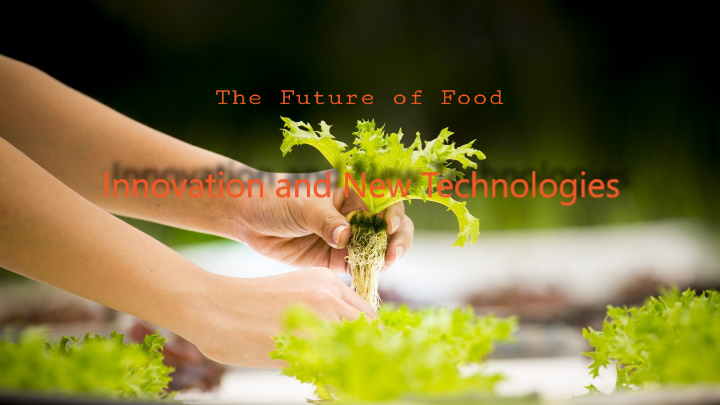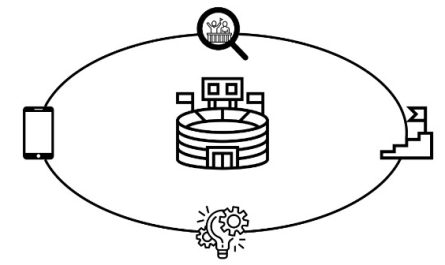Keywords such as “innovation” and “digitization” combined with the term “new technologies” have been a constant for my eyes and ears for the last couple of years, and are so common in the professional world that I can’t help but roll my eyes whenever I hear the words being outspoken. Nevertheless, I would be neglecting the transcendence of these terms if I wouldn’t mention them in a main topic titled the future of food.
Having learned on my previous blog posts about what food systems are and in general terms what is to be done in order to change the status quo, I want to focus on the practical aspect of things.
Taking into account some of the devastating effects global warming is having upon agriculture such as droughts, flooding, and extreme weather events, one of the most noticeable challenges that food systems face, is feeding a growing population without destroying more of our planet. UN reports expect the world’s population to increase to almost 10 billion by 2050, while food demand is expected to range between 40% to 54% more of today’s demand according to the Food and Agriculture Organization (FAO).
On this post I would like to list some of the innovations that could have a substantial impact on our food systems moving forward. If you feel like continuing the netflix mode during this crisis go to the end of this post to see in a video how best practices are being achieved in the Netherlands. If you do want to read a bit, bare with me for next 6-7 minutes.
1. Sustainable intensification
Arable land is limited and eliminating vegetation in order to grow crops beats the purpose of limiting or even reducing greenhouse gas emissions on agriculture. The main idea behind sustainable intensification is producing more with less natural resources. The Royal Society, a fellowship of many of the world’s most eminent scientists defines SI as “yields are increased without adverse environmental impact and without the cultivation of more land”. It is more of a general guiding principle for the development of agriculture, than an innovation. Fairly new and evolving as a concept, it is open for different interpretations. The consensus among experts are the principles of:
- frozen agricultural land footprint
- Reduced environmental impacts
- Increased yields
2. Precision agriculture
With the use of smart technology, farmers can manage their farm from a digital device to control tractors with integrated GPS and tell crop watering systems to turn on or off. Sensors can measure soil, air temperature and humidity on fields, and drones and satellites are used to collect and analyse data to help inform how farmers should look after their crops. Precision agriculture provides the tools and data for deep analysis of farming practices whether on individual farms, in regions or in countries. Information about the soil, water and land features allows farmers to optimize the usage of this same resources
3. AI, Automation and IoT
But how could tractors take care of farms without somebody operating them? Smart Ag, a company from Ames, Iowa (USA) developed Autocart, a cloud-based software that allows farmers to automate their tractors and maximize efficiency and capacity.
AI is also being used for weather prediction, soil health monitoring and crop health monitoring. Proximity sensing, remote sensing techniques, image recognition and processing, along with hyperspectral imaging and 3d laser scanning are some of the technologies the company Webtunix uses to help farmers detect soil nutrient deficiency, diseases, pests or whether fertilizer is needed and where.
4. Indoor and Vertical Farming
Indoor vertical farming might be the solution for the dilemma that farming land is limited. But also urban centers or regions lacking fertile land needing transportation and logistics in order to bring in produce for their population could really take advantage of this technologies. As stated on its website, Infarm combines highly efficient vertical farms with IoT technologies and Machine Learning, to offer an alternative food system that is resilient, transparent, and affordable. Their visionary mission: helping cities become self-sufficient in their food production while significantly improving the safety, quality, and environmental footprint of our food. As of today, the company was able to save 3.7 million liters of water, 1.8 million transport-kilometers and 29’000 square meters of land. The system is designed to be infinitely scalable: you simply add more modules, and as they are cloud based, the farms can be monitored and controlled from Infarm’s central control centre.
5. Plant Breeding Innovation
This term encompasses evolving ideas or practices that enhance the field of plant breeding. Cell biology, gene mapping and marker-assisted breeding are some of the science and technologies currently being used in plant breeding. The International Seed Federation (ISF) states that innovation can help produce improved varieties of plants that sustain and potentially increase yields and are better adapted to withstand disease and the effects of climate change, such as drought or floods, supporting sustainable agriculture and food security. The risks and negative effects that editing genomes of plants could have in our ecosystem in the long run should be thoroughly investigated.
To conclude I would like to leave you with one of the best practices I came across and that inspired me some hope:
Sources:
Fraanje, W., & Lee-Gammage, S. (2018). What is sustainable intensification? | FCRNfoodsource. Foodsource, Food Climate Research Network (FCRN).
ISF. (n.d.). Plant Breeding Innovation – International Seed Federation. Worldseed.Org. Retrieved April 26, 2020, from
Levy, W. (2017). A smart farming approach to agriculture. TECHNICAL CENTRE FOR AGRICULTURAL AND RURAL COOPERATION (CTA).
O’Hear, S. (2019). Infarm closes $100M Series B to scale its ‘urban farming platform’ | TechCrunch. Techcrunch.



